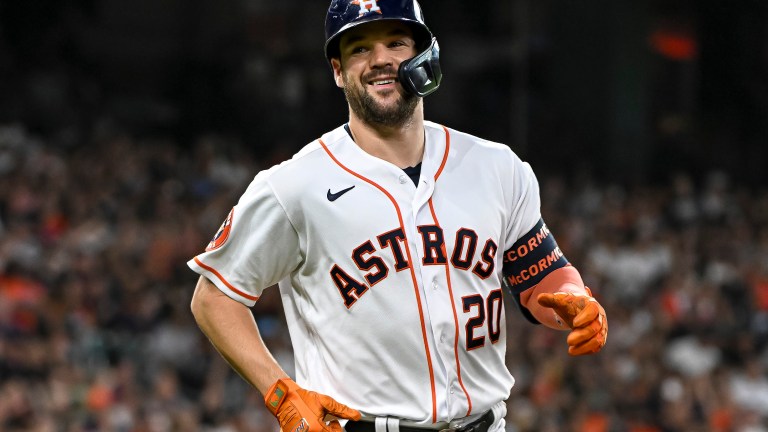What Will the Astros Do About Their Outfield After Trading Kyle Tucker?
The outfield stands as the primary area of need for Houston to address this offseason.

The Houston Astros outfield for 2025, as it stands, doesn’t inspire much confidence that the team can be an offensive powerhouse like in years past. After trading Kyle Tucker, there’s only one word to describe the state of the Astros outfield right now: bad.
Assuming Yordan Alvarez will get most of his 2025 reps at DH, Chas McCormick, Jake Meyers and former top prospect Taylor Trammell are the most likely in-house options to man the outfield for Houston this year. Meyers had the highest wRC+ of that group last year at 86.
McCormick failed to recreate the magic of his 2023 season, when he hit for a wRC+ of 133, and instead was sent to Triple-A in August after struggling badly. Trammell struck out three times in eight MLB plate appearances in 2024 and spent most of his year at Triple-A in the Yankees system.
The outfield stands as the biggest hole remaining for the Astros to fill this offseason. To that point, GM Dana Brown noted last month the team could still pursue a left-handed hitting outfielder.
Could Houston Wait Until Next Winter To Address the Outfield?
Anthony Santander to the Astros? Jurickson Profar in Houston? That’s not likely.
The Astros had the highest payroll in club history in 2024 and paid the luxury tax for the first time. Each consecutive year a club goes over the luxury tax, the tax penalties increase, and the more money spent, the higher the tax.
Signing one of the big guys left on the market would certainly mean an increase in Houston’s tax bill.
But if a club goes under the luxury tax for a season, those penalties reset. So, the Astros have good reason to wait to open their wallets.
If the Astros manage to go under the luxury tax this season, the penalties will reset for 2026, a year in which the contracts of José Abreu, Rafael Montero, Framber Valdez, Victor Caratini and Ryan Pressly will all be off the books. According to RosterResource, those contracts equal roughly $69 million.
In a long-term view, it would be enticing for the Astros brass to be a little more conservative with funds now (or aggressive in offloading salary) in order to spend big later.
Dana Brown has shown a desire to extend some of the club’s younger talent, as seen by Cristian Javier’s five-year extension and former promises to extend Tucker and Alex Bregman. Waiting to spend could help the Astros to eventually lock up Hunter Brown or Yainer Diaz to below-market deals, which would fall right into their typical style of spending.
The Astros are currently above the first threshold for the luxury tax by $3 million according to Roster Resource, so they could look to offload before they add this winter.
Cheap Lefty Bats the Astros Could Turn To
For those luxury tax reasons, Houston is likely done with big spending this offseason after giving Christian Walker $20 million annually over the next three years. Still, there are cheap options on the market if they want to add.
The Astros didn’t have a problem last season giving runway to an inexpensive, DFA’d veteran in Jason Heyward and a journeyman in Ben Gamel, so with not much payroll flexibility left, they could add a bat from a similar tier.
Here are some lefty free agent bats that might fall within Houston’s financial comfort zone.
Jason Heyward
Heyward put together a decent showing for the Astros with a 112 OPS+ after they picked him up off waivers in August. Counting on a 35-year-old Heyward to replicate those numbers (he has a career 102 OPS+) seems unwise, but the Astros might value his glove and his veteran leadership.
David Peralta
David Peralta is beginning to reach journeyman status after spending parts of his first nine seasons with the Diamondbacks. He was relegated to a platoon role with the Padres in 2024 and had moderate success, putting up a 116 wRC+ against righties in 88 games.
Peralta only had 20 ABs against lefties last season, likely making him just a platoon option with Mauricio Dubón in a corner outfield spot.
Jesse Winker
Jesse Winker has major talent with the bat in his hands, but down years with the Mariners and Brewers in 2022 and 2023, respectively, have shielded that fact from the public. He averaged a 129 OPS+ per season from 2017-2021 before posting a 103 OPS+ in 2022 with Seattle and a 59 OPS+ with Milwaukee in 2023.
2024 saw Winker regain some of his past form, as he produced a .253/.360/.405 slash with both the Nationals and Mets, putting up a 122 OPS+.
Dylan Carlson
Dana Brown has taken a flyer on a former top prospect in Trammell. He could look to take a flyer on another former top prospect in Dylan Carlson, who has a bit more of a track record against big league pitching.
The first-round pick finished third in NL Rookie of the Year voting in 2021 for the Cardinals but has posted a below-average OPS+ in the three seasons following. He’s only 26, and given his performance the past few years, he’s a change of scenery candidate with upside who may be willing to accept a minor league deal with an invite to spring training.
Alex Verdugo
Alex Verdugo didn’t have the best walk year after being traded by the Red Sox to the Yankees before the 2024 season, having his worst season to date with an 83 OPS+.
He’s another change of scenery candidate, as he’s shown flashes of his former prospect pedigree. He’d also be able to grow back his beard – something that all baseball fans will be able to celebrate.
The Best Internal Option
Since the Astros are roughly $3 million over the first luxury tax threshold, they may withhold their funds altogether and roll with some of their young guys.
The team’s minor league system is devoid of any major impact talent that can make an immediate impact in the outfield next year, but Houston does have options if they want to play certain matchups or platoon with Dubón in the outfield.
Zach Dezenzo
Zach Dezenzo is an option for a corner outfield spot, having already had a 19-game cup of coffee in the big leagues in 2024.
Ranked as Just Baseball’s 83rd overall prospect at the end of the 2024 season and the Astros’ sixth-ranked prospect per MLB.com, he posted a .914 OPS across High-A and Double-A in 2023 before earning an August call-up by posting a .998 OPS in Triple-A across 25 games.
His brief stint in the majors didn’t go as smoothly. He struck out 22 times in 19 games and only walked twice, posting a .648 OPS and an 84 WRC+. However, he did show off plus game power with two 435-foot-plus homers leaving the ballpark at 106.7 MPH and 108.6 MPH.
The 24-year-old sported a max exit velocity of 112.2 MPH in his small MLB sample size and ranked 32nd in bat speed (75.4 MPH) out of players with a minimum of 25 swings.
Dezenzo’s problem is his limited experience in the outfield. He has received playing time this year in the outfield in the Puerto Rican Winter League and played three games in left field in Triple-A last season.
He got the majority of his MLB reps at first base last year during his short stint with the team, but with Walker manning first for the next three years, Dezenzo will likely have to learn multiple positions to find consistent time.
Whether the Astros are confident enough in his outfield defense is a question, but they seem to be looking for that answer by having him play outfield in Puerto Rico.
The Astros’ offseason moves say two things about the front office mindset: They’re trying to compete, and they’re being realistic about the state of the franchise.
If the Astros are truly trying to compete, expect them to add a bat in some form, because realistically, it’s not easy to make a deep playoff run with one of the worst outfields in MLB.
